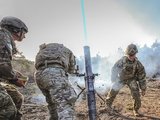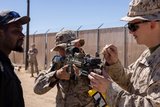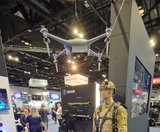Australia looks to harness ARV capabilities
Potential defence applications of Augmented Reality Visualisation (ARV) have been highlighted during an Australian defence and industry demonstration day on 25 October.
The event - an initiative of Jericho Dawn - involved input from the Defence Science and Technology Group (DST Group) and Saab Australia.
Holographic software from Saab Australia, and the Microsoft HoloLens, were used to show how defence could harness ARV capabilities for future planning and training applications – something set to be exploited as part of the Royal Australian Air Force’s (RAAF's) transition to a 5th generation fighting force.
The HoloLens – which looks like a cross between normal reading glasses and ski goggles - is a commercial, untethered and self-contained wearable device that allows a user to visualise holographic images and participate in ARV.
Jericho Dawn and DST Group are providing seed funding for Saab Australia - who are a Microsoft partner for the development of applications for use with HoloLens - to design tools for DST Group to demonstrate the future of this capability for the RAAF.
GPCAPT Pete Mitchell, the director of Plan Jericho, said that the success of Jericho and technologies such as HoloLens depended on a careful balance between imagination and innovation.
‘The future could be stated as either limitless or limited by your imagination. ARV is a rapidly emerging technology with possible applications in fields as diverse and far ranging as medical science, research, chemistry, training, education and remote industry application - to name just a few possibilities.
‘It is our job to explore the possibilities ARV can afford air force and this demonstration is one step in examining this potential. As ARV applications become more commercial and mainstream we expect this potential to grow exponentially.’
More from Training
-
![Cubic tailors mortar simulator for the US Army]()
Cubic tailors mortar simulator for the US Army
The company’s mortar trainer received improvements based on soldier’s feedback.
-
![Saab expands footprint in the US]()
Saab expands footprint in the US
The company will operate in two new locations in the coming years to better support US services.
-
![How terrain management capabilities can improve military training]()
How terrain management capabilities can improve military training
This type of tool provides more realistic training easing the incorporation of new scenarios that accurately represent the threats of the battlefield.
-
![I/ITSEC 2024: Australian Army approaches second phase of countermining training]()
I/ITSEC 2024: Australian Army approaches second phase of countermining training
The Engineering Corps has been conducting individual instruction using FLAIM Systems’ Sweeper and should start collective deployments in 2025.
-
![I/ITSEC 2024: Zeiss introduces Velvet 4K SIM projector for night flight simulation]()
I/ITSEC 2024: Zeiss introduces Velvet 4K SIM projector for night flight simulation
The next-generation platform is motion-compatible and can be used in OTW and NVG applications.
-
![I/ITSEC 2024: Saab introduces UAV live training capability]()
I/ITSEC 2024: Saab introduces UAV live training capability
The system can be used to prepare soldiers for both drone offensive operations and CUAS missions.


























